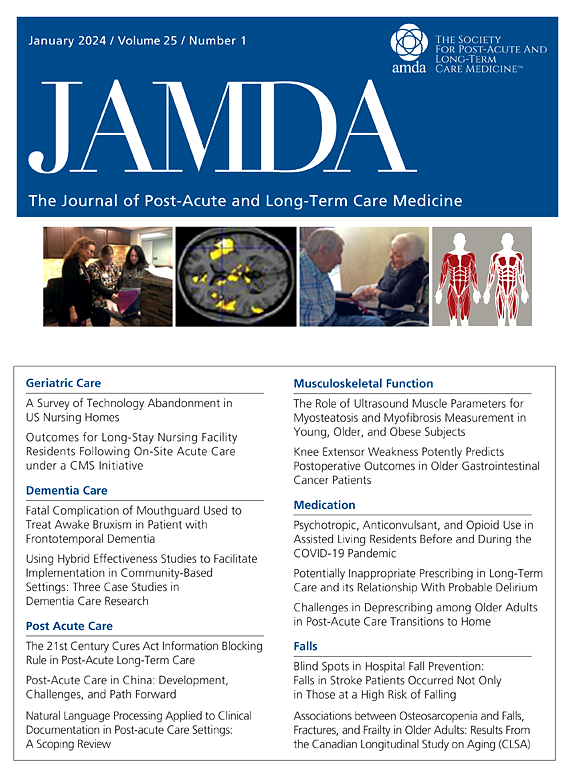Impact of an Artificial Intelligence and Machine Learning Enhanced Electronic Health Record System on Quality Measures in Nursing Homes: A Difference-in-Differences Analysis
IF 4.2
2区 医学
Q2 GERIATRICS & GERONTOLOGY
Journal of the American Medical Directors Association
Pub Date : 2025-05-28
DOI:10.1016/j.jamda.2025.105680
引用次数: 0
Abstract
Objectives
This study evaluated the impact of an electronic health record (EHR) system enhanced with artificial intelligence and machine learning (EHR+AI) on quality measures in nursing homes in the United States.
Design
A difference-in-differences (DiD) design was used to estimate the effect of the EHR+AI intervention on quality measures among nursing homes with and without the AI intervention. The intervention included a feature that analyzed 150 daily clinical data elements per patient, alerting staff to changes in conditions, acuity, fall risk, and medication monitoring.
Setting and Participants
The analysis included 218 nursing homes, with 94 using EHR+AI and 124 using EHR only. Baseline differences in organizational characteristics, acuity index, neighborhood affluence, and racial or ethnic composition were evaluated.
Methods
Eighteen quality measures from the Centers for Medicare and Medicaid Services (CMS) were analyzed over 6 quarters before and 5 quarters after EHR+AI implementation. A DiD approach with linear mixed effects models was used, adjusting for significantly different baseline characteristics.
Results
Statistically greater improvements were observed in 16 of 18 quality measures (89%) in EHR+AI sites, with 11 measures (61%) also meeting the parallel trends assumption. Notably, EHR+AI sites demonstrated larger improvements in functional status, including greater reductions in major falls (−9%, 95% CI –17, −1; P = .034) and residents needing help with daily activities (−22%, 95% CI –29, −15; P < .001), and a 5% larger increase in residents who made improvements in function (95% CI 2, 7; P = .001). Higher decline in depressive symptoms and the use of antipsychotic, antianxiety, or hypnotic medications were also noted. These results were observed among sites with higher patient acuity and neighborhood diversity.
Conclusions and Implications
These findings suggest that an EHR enhanced with AI can improve the quality and efficiency of care in nursing homes through real-time monitoring and response of resident assessment protocol triggers for clinical modification, but further research is needed.
人工智能和机器学习增强的电子健康记录系统对养老院质量措施的影响:差异中的差异分析。
目的:本研究评估了人工智能和机器学习(EHR+AI)增强的电子健康记录(EHR)系统对美国养老院质量措施的影响。设计:采用差异中的差异(DiD)设计来评估有和没有人工智能干预的EHR+人工智能干预对养老院质量措施的影响。干预措施包括分析每位患者150个日常临床数据元素的特征,提醒工作人员注意病情、敏锐度、跌倒风险和药物监测的变化。环境和参与者:分析包括218家养老院,94家使用电子病历+人工智能,124家只使用电子病历。评估了组织特征、敏锐度指数、社区富裕程度和种族或民族构成的基线差异。方法:对医疗保险和医疗补助服务中心(CMS)实施EHR+AI前6个季度和实施后5个季度的18项质量指标进行分析。采用线性混合效应模型的DiD方法,根据显著不同的基线特征进行调整。结果:在EHR+AI站点中,18项质量测量中有16项(89%)有统计学上较大的改善,其中11项(61%)也符合平行趋势假设。值得注意的是,EHR+AI站点显示出更大的功能状态改善,包括更大的跌倒减少(-9%,95% CI -17, -1;P = 0.034),居民在日常活动中需要帮助(-22%,95% CI -29, -15;P < 0.001),功能改善的居民增加了5% (95% CI 2,7;P = .001)。研究还指出,抑郁症状的明显减轻以及抗精神病、抗焦虑或催眠药物的使用。这些结果在患者视力和社区多样性较高的地点观察到。结论和意义:这些研究结果表明,人工智能增强的电子病历可以通过实时监测和响应住院医师评估协议触发因素来提高养老院的护理质量和效率,但需要进一步的研究。
本文章由计算机程序翻译,如有差异,请以英文原文为准。
求助全文
约1分钟内获得全文
求助全文
来源期刊
CiteScore
11.10
自引率
6.60%
发文量
472
审稿时长
44 days
期刊介绍:
JAMDA, the official journal of AMDA - The Society for Post-Acute and Long-Term Care Medicine, is a leading peer-reviewed publication that offers practical information and research geared towards healthcare professionals in the post-acute and long-term care fields. It is also a valuable resource for policy-makers, organizational leaders, educators, and advocates.
The journal provides essential information for various healthcare professionals such as medical directors, attending physicians, nurses, consultant pharmacists, geriatric psychiatrists, nurse practitioners, physician assistants, physical and occupational therapists, social workers, and others involved in providing, overseeing, and promoting quality

 求助内容:
求助内容: 应助结果提醒方式:
应助结果提醒方式:


